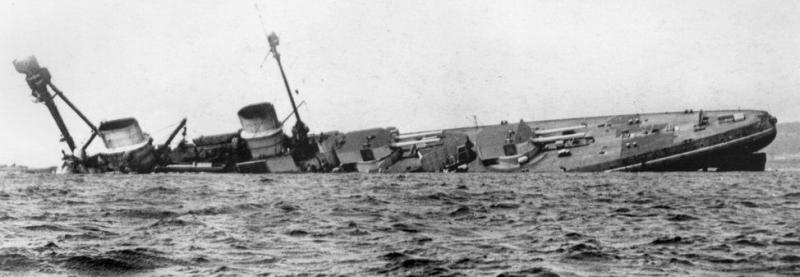
German battle Cruiser Derfflinger Image: Orkney Library and Archive
Following the Armistice of November 11, 1918, which ended fighting on land, sea, and air in World War I, the German High Seas Fleet of 74 ships was interned at Scapa Flow, in the Orkney Islands of Scotland. While the armistice ended the fighting, it would still take six months of Allied negotiations at the Paris Peace Conference to conclude the peace treaty. Part of the haggling over terms of the treaty involved how to divide up the ships of the German fleet amongst the victors.
On the morning of June 21, 1919, German Admiral Erich Raeder, in command of the interned ships, sent out a flag signal, “To all Commanding Officers and the Leader of the Torpedo Boats. Paragraph Eleven of today’s date. Acknowledge. Chief of the Interned Squadron.” The signal was repeated by semaphore and searchlights.
The British had no idea what the message meant, but the German officers understood. It was an order to scuttle the fleet. Sea valves were opened, as were watertight doors and ports. Within hours the mighty battleships, cruisers, and destroyers began to settle and list. The battleship Friedrich der Grosse was among the first to begin to sink, listing heavily to starboard. In defiance, it raised the Imperial German Ensign on its mainmast. Soon all the rest of the fleet followed suit. The Hindenburg, the biggest German battlecruiser, was the last to sink.
The crews took to the boats to abandon the sinking ships. The Royal Navy attempted to stop the scuttling but there was nothing that they could do. Initially, the unarmed German sailors in the boats were fired upon by the British, killing nine. They were the last to die in World War I. Ultimately, 1,774 German sailors were picked up and transported to a prisoner of war camp.
The scuttling has been described as the “single greatest loss of warships in history.” Of the 74 German ships at Scapa Flow, 54 sank, comprising 15 of the 16 capital ships, 5 of the 8 cruisers, and 32 of the 50 destroyers. The remainder either remained afloat or were towed to shallower waters and beached.
During the 1920s and ’30s many of the 52 ships were lifted from the sea bed by commercial contractors and broken up. The seven wrecks that remain are now classed as scheduled monuments, nationally important archaeological sites given protection against unauthorised change.
Oddly enough, the three battleships Markgraf, König and Kronprinz Wilhelm were sold on eBay in 2019, (by the retiring diving contractor Tommy Clark) for £25,500 each to a Middle Eastern company. The cruiser, Karlsruhe, sold for £8,500 to a private bidder in England.

You have to be careful what you bid for on Ebay after a few beers on a Saturday night!